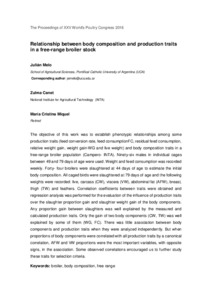Por favor, use este identificador para citar o enlazar este ítem:
https://repositorio.uca.edu.ar/handle/123456789/13774| Campo DC | Valor | Lengua/Idioma |
|---|---|---|
| dc.contributor.author | Melo, Julián E. | es |
| dc.contributor.author | Canet, Zulma E. | es |
| dc.contributor.author | Miquel, María Cristina | es |
| dc.date.accessioned | 2022-04-07T12:33:41Z | - |
| dc.date.available | 2022-04-07T12:33:41Z | - |
| dc.date.issued | 2016 | - |
| dc.identifier.citation | Melo, J.E. Canet, Z.E., Miquel, M.C. Relationship between body composition and production traits in a free-range broiler stock [en línea]. The Proceedings of XXV World's Poultry Congress 2016 Disponible en: https://repositorio.uca.edu.ar/handle/123456789/13774 | es |
| dc.identifier.uri | https://repositorio.uca.edu.ar/handle/123456789/13774 | - |
| dc.description.abstract | Abstract: The objective of this work was to establish phenotypic relationships among some production traits (feed conversion rate, feed consumptionFC, residual feed consumption, relative weight gain, weight gain-WG and live weight) and body composition traits in a free-range broiler population (Campero- INTA). Ninety-six males in individual cages between 49 and 79 days of age were used. Weight and feed consumption was recorded weekly. Forty- four broilers were slaughtered at 44 days of age to estimate the initial body composition. All caged birds were slaughtered at 79 days of age and the following weights were recorded: live, carcass (CW), viscera (VW), abdominal fat (AFW), breast, thigh (TW) and feathers. Correlation coefficients between traits were obtained and regression analysis was performed for the evaluation of the influence of production traits over the slaughter proportion gain and slaughter weight gain of the body components. Any proportion gain between slaughters was well explained by the measured and calculated production traits. Only the gain of two body components (CW, TW) was well explained by some of them (WG, FC). There was little association between body components and production traits when they were analyzed independently. But when proportions of body components were correlated with all production traits by a canonical correlation, AFW and VW proportions were the most important variables, with opposite signs, in the association. Some observed correlations encouraged us to further study these traits for selection criteria. | es |
| dc.format | application/pdf | es |
| dc.language.iso | eng | es |
| dc.publisher | World's Poultry Science Association | es |
| dc.rights | Acceso abierto | * |
| dc.rights.uri | http://creativecommons.org/licenses/by-nc-sa/4.0/ | * |
| dc.source | The Proceedings of XXV World's Poultry Congress 2016 | es |
| dc.subject | PRODUCCION AVICOLA | es |
| dc.subject | POLLO DE ENGORDE | es |
| dc.subject | POLLOS PARRILLEROS | es |
| dc.title | Relationship between body composition and production traits in a free-range broiler stock | es |
| dc.type | Documento de conferencia | es |
| uca.disciplina | INGENIERIA EN ALIMENTOS | es |
| uca.issnrd | 1 | es |
| uca.affiliation | Fil: Melo, Julián E. Pontificia Universidad Católica Argentina. Facultad de Ciencias Agrarias; Argentina | es |
| uca.affiliation | Fil: Canet, Zulma E. Instituto Nacional de Tecnología Agropecuaria; Argentina | es |
| uca.affiliation | Fil: Miquel, María Cristina. Investigadora retirada; Argentina | es |
| uca.version | acceptedVersion | es |
| item.languageiso639-1 | en | - |
| item.grantfulltext | open | - |
| item.fulltext | With Fulltext | - |
| Aparece en las colecciones: | Ponencias | |
Ficheros en este ítem:
| Fichero | Descripción | Tamaño | Formato | |
|---|---|---|---|---|
| relationship-between-body.pdf | 12,47 kB | Adobe PDF |  Visualizar/Abrir |
Visualizaciones de página(s)
39
comprobado en 27-abr-2024
Descarga(s)
19
comprobado en 27-abr-2024
Google ScholarTM
Ver en Google Scholar
Este ítem está sujeto a una Licencia Creative Commons

